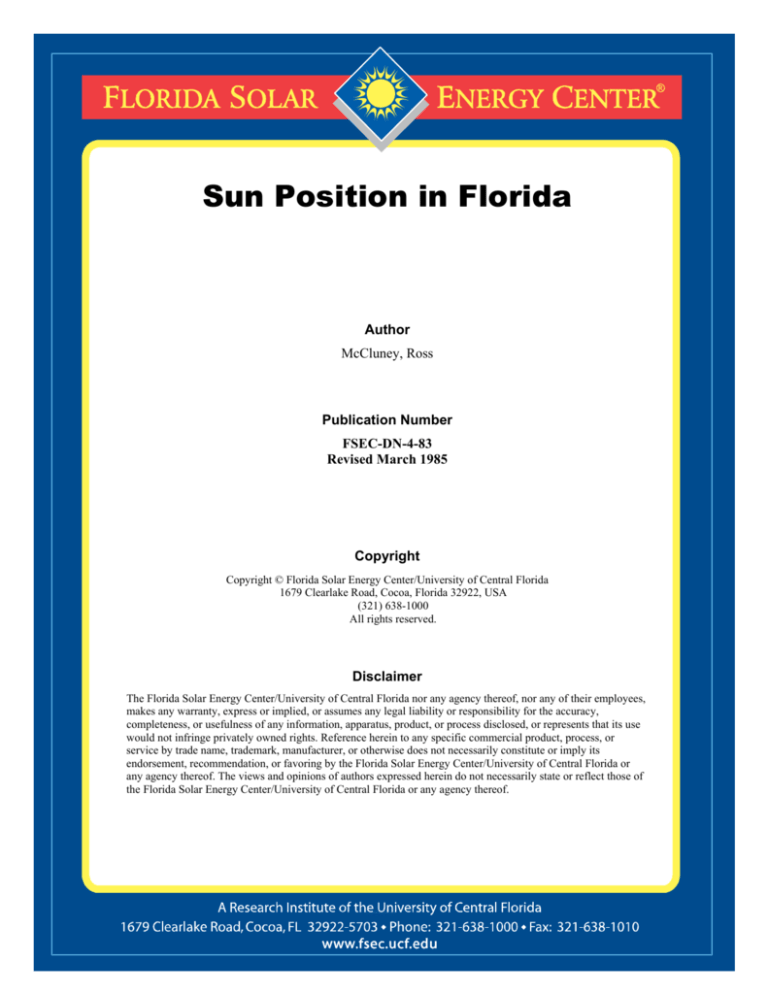
Sun Position in Florida
Author
McCluney, Ross
Publication Number
FSEC-DN-4-83
Revised March 1985
Copyright
Copyright © Florida Solar Energy Center/University of Central Florida
1679 Clearlake Road, Cocoa, Florida 32922, USA
(321) 638-1000
All rights reserved.
Disclaimer
The Florida Solar Energy Center/University of Central Florida nor any agency thereof, nor any of their employees,
makes any warranty, express or implied, or assumes any legal liability or responsibility for the accuracy,
completeness, or usefulness of any information, apparatus, product, or process disclosed, or represents that its use
would not infringe privately owned rights. Reference herein to any specific commercial product, process, or
service by trade name, trademark, manufacturer, or otherwise does not necessarily constitute or imply its
endorsement, recommendation, or favoring by the Florida Solar Energy Center/University of Central Florida or
any agency thereof. The views and opinions of authors expressed herein do not necessarily state or reflect those of
the Florida Solar Energy Center/University of Central Florida or any agency thereof.
FSEC-DN-4-83
Note
Revised March 1 9 8 5
Sun position in Florida
Ross McCluney
Principal Research Scientist
Described herein is a procedure for determining the
path of the sun through the Florida sky relative to a solar
collector array, a window, a skylight or an entire building
- information needed by architects, engineers and
others for shading and orientation calculations involved
in active and passive building design. It can be used for
positioning exterior shading devices for maximum benefit.
This information can also be used to pinpoint solar collector shading problems.
The apparent paths of the sun in midwinter and midsummer in central Florida are shown in Figure 1. In win-
Florida Solar Energy Center
versa, is provided in an FSEC research memorandum,
RM-5-80. Each sun path curve plotted in Figures 3
through 5 is for the 21st day of the month indicated and
for latitudes there indicated. For locations near the north
and south zone boundaries, the solar positions given in
Figures 3 - 5 will contain a small error, but one which is
insignificant for most applications.
These data are calculated following a procedure published by the American Society of Heating, Refrigerating
& Air Conditioning Engineers Inc. They give approximate positions only. True sun positions may differ from
Solar noon
Solar noon
S
N
E
Sunrise
June 21
December 21
Figure 1. Sun path diagrams for 2 8 O north.
ter the sun rises south of due east, to a maximum elevation of about 38" above the horizon at noon, and sets
south of due west. In summer, the sun rises north of due
east, to an elevation of about 86O at noon, and sets north
of due west.
The compass directions (azimuths) of the sun at sunrise and sunset, as well as its maximum elevation angle
for a given day of the year, vary with the latitude of the
observer. The approximate coordinates of a particular
Florida location can be determined with the aid of the
Figure 2 map.
31
30
29
28
27
26
Sun Path Diagrams
To determine the path of the sun through the sky for a
given location, first identify which zone you are in (using
Figure 2); sun paths can then be ascertained from Figures
3 through 5. All times are solar time, solar noon being
the time of maximum solar elevation locally. A procedure
for converting from solar to local standard time, or vice
2s
Figure 2. Map of Florida showing zones
for calculating sun positions.
the predicted values by a small amount. For sun path
diagrams for locations outside Florida, see references
1 and 2.
Once the appropriate sun path diagram has been
selected for a given location, one can determine the
extent of shading produced by various obstructions, or
the times of day and year when direct solar radiation can
strike points within a building through openings in the
walls and roof. The key to doing this is the determination
of the azimuth (or bearing) and elevation angles of the
corners of the shading objects relative to the point of
interest.
Latitude: 2 6 O
Latitude: 30°
Azimuth angle in degrees
Figure 5. Sunpath plot for zone 3.
Opaque Shading Objects
Azimuth angle in degrees
Figure 3. Sunpath plot for zone 1.
For example, suppose a solar collector is planned for a
site which has a tall building to the southeast of it as
depicted in Figure 6. If the top two corners of this building closest to the site have elevation angles of 55" and 65"
respectively above the horizon relative to the proposed
site, and if their corresponding azimuth angles (measured
clockwise from north) are 135" and 105"respectively,
then these two points may be connected by a line on the
sun path diagram as shown in figure 7. The space on
the sun path diagram directly below this plotted line
segment indicates the dates and times when the proposed
site will be shaded by the building.
Latitude: 2E0
a. Side (section) view of site and building.
Azimuth angle in degrees
Figure 4. Sunpath plot for zone 2.
Site
b. Top (plan) view of inside location and window.
Note: 8% X 11" enlargements of Figures 3-5 and Figure 11
(which can be used directly or to produce transparencies)
are available on request. Write to the FSEC Public information Office, Cape Canaveral, FL 32920
2
3
Figure 6. Locating the altitude (a) and azimuth
(b) angles of a potentially obstructing building.
Design Note
Azimuth angle in degrees
Figure 7. Identifying times of direct solar shading
produced by a building southeast of the site.
Figure 9. Identifying times of direct solar transmission through a window on the southeast side of a
building to a particular location in the interior.
Windows
The entry of direct solar radiation through a window or
skylight to a point inside the building can similarly be predicted by plotting the coordinates of the corners of the
aperture on a sun path diagram. (See Figures 8 and 9.)
Note that if a roof overhang or other exteror structure
is visible through the window it is the coordinates of
this structure that must be used for that portion of
the aperture.
Outdoors
a. Side (section) view of inside location and window.
Indoors
Outdoors
interest
b. Top (plan) view of site and building.
Figure 8. Locating the altitude (a) and azimuth
(b) angles of the four corners of a window.
Florida Solar Enerav Center
Roof Overhangs
Let H be the height of a roof overhang above a point
on a wall of interest (which may be either the top or bottom of a window, or some other aperture). Let W be the
width of the overhang from the outside wall. The ratio
H/W is called the overhang ratio.
Referring to Figure 11let a. be the azimuth angle
(clockwise from north) of a perpendicular to the wall.
(aois the compass direction toward which the wall faces.)
Let be the azimuth angle of the sun, and let A@ be the
relative solar azimuth angle, the azimuth angle of the sun
from the perpendicular to the wall.
It can be shown that the altitude angles 0,and relative
solar azimuth angles for points along the edge of the roof
overhang are related by the following equation, which is
called the roof overhang shading transition curve:
43 = arctan
This equation has been evaluated for several different
values of the overhang ratio, and the results are plotted in
Figure 12.
A tracing (or photograph with no magnification) of this
figure on transparent plastic or paper can be placed over
the appropriate sun path diagram to easily identify the
times of shading of the point on the wall. The short vertical line in this tracing at zero relative azimuth should be
placed to coincide with the azimuth angle of the wall on
one of the sun path plots, in Figure 3 - 5. The desired
shading transition curve can then be easily identified on
the sun path plot, as is illustrated in Figure 12. Once this
curve has been drawn on the sun path plot for your zone,
it is easy to determine the days and hours of the year
(below the line) when direct sunlight will reach the point
on the wall (or a window) of interest. The point never
receives direct solar radiation for times above the curve
in Figure 12.
3
r
Sun Overhang ratio
=H
W
a. Side (section) vlew of window and roof overhand.
North
Azimuth angle in degrees
Figure 12. Roof overhang shading transition
curve for a wall with 135O azimuth angle and an
overhang ratio of 1.5.
-w--N
Selected References
b. Top (plan view of window and roof overhand
Figure 10. Locating the altitude ( 0 ) and relative
azimuth (A*) angles of various points along the
edge of a roof overhang.
90
80
1. Bennett, Robert, Sun Angles for Design,
6 Snowden Road, Bala Cynwyd, PA 19004.
2. "Sunpath Diagrams," HP User's Library, 1000 N.E.
Circle Blvd., Corvallis, OR 97330.
3. R. McCluney, Roof Overhangs and Solar Time
(supplement to Sun Position in Florida),
FSEC-RM-5-80(RD) Public Information Office,
Florida Solar Energy Center, Cape Canaveral,
FL 32920.
70
Overhang ratio = 2.0
m
$
60
@
Copyright 1983 by Florida Solar Energy Center.
0
0,
.E 50
-
P,
0)
5
40
0
0,
a
30
20
10
......................................
0
m 0m 0y 0y !0 ?0p0? 0v 0y
0
0
0
0
0
0
0
0
0
0
- N O " ~ C O h m m
Azimuth angle in degrees
Figure 11. Roof overhang shading transition curves.
4
Design Note








